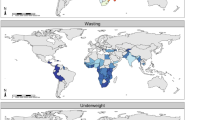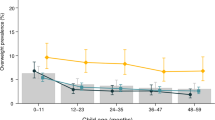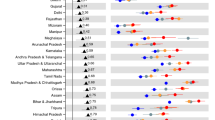Abstract
Objective
We sought to examine changes in regional and sex disparities in stunting, thinness, and overweight among Chinese school-aged children from 1985 to 2014.
Methods
We analyzed data on 1,489,953 children aged 7–18 years in the Chinese National Survey on Students’ Constitution and Health. Stunting, thinness, and overweight were defined according to WHO anthropomorphic definitions. After adjustment for age, socioeconomic status, and school, logistic regression was used to estimate the prevalence of stunting, thinness, and overweight by region and sex over 30 years’ time.
Results
From 1985 to 2014, the prevalence of stunting progressively decreased from 16.4% in 1985 to 2.3% in 2014, thinness prevalence also declined overtime, from 8.4 to 4.0% and overweight prevalence continually increased from 1.1% in 1985 to 20.4% in 2014 in Chinese school-aged children. Stunting and thinness were more common in rural areas, although urban/rural differences declined over time. Overweight was a greater problem in urban than rural areas, and this difference increased over time. Some provinces showed high levels of stunting, thinness, and overweight. The stunting prevalence of boys was higher than girls from 1985 and 1995, but lower than girls for the past 15 years. Thinness was consistently more common in boys than girls across regions and time. Overweight continuously increased for boys and girls; however, the increase was more rapid in boys.
Conclusions
Over the past 30 years, Chinese children have shifted in anthropomorphic measures indicating a shift from problems of under-nutrition to measures consistent with over-nutrition, particularly in urban areas and among boys. Some regions are burdened by problems of both under- and over-nutrition. Regional and sex-specific guidelines and public health policies for childhood nutrition are needed in China.
This is a preview of subscription content, access via your institution
Access options
Subscribe to this journal
Receive 12 print issues and online access
$259.00 per year
only $21.58 per issue
Buy this article
- Purchase on Springer Link
- Instant access to full article PDF
Prices may be subject to local taxes which are calculated during checkout



Similar content being viewed by others
References
Lobstein T, Jackson-Leach R, Moodie ML, Hall KD, Gortmaker SL, Swinburn BA, et al. Child and adolescent obesity: part of a bigger picture. Lancet. 2015;385:2510–20.
GBD 2015 Risk Factors Collaborators. Global, regional, and national comparative risk assessment of 79 behavioural, environmental and occupational, and metabolic risks or clusters of risks, 1990–2015: a systematic analysis for the Global Burden of Disease Study 2015. Lancet. 2016;388:1659–724.
Conde WL, Monteiro CA. Nutrition transition and double burden of undernutrition and excess of weight in Brazil. Am J Clin Nutr. 2014;100:1617S–22S.
Kroker-Lobos MF, Pedroza-Tobías A, Pedraza LS, Rivera JA. The double burden of undernutrition and excess body weight in Mexico. Am J Clin Nutr. 2014;100:1652S–8S.
Ma J, Wang Z, Song Y, Hu P, Zhang B. BMI percentile curves for Chinese children aged 7–18 years, in comparison with the WHO and the US Centers for Disease Control and Prevention references. Public Health Nutr. 2010;13:1990–6.
Jafar TH, Qadri Z, Islam M, Hatcher J, Bhutta ZA, Chaturvedi N. Rise in childhood obesity with persistently high rates of undernutrition among urban school-aged Indo-Asian children. Arch Dis Child. 2008;93:373–8.
Popkin BM, Adair LS, Ng SW. Now and then: the global nutrition transition: the pandemic of obesity in developing countries. Nutr Rev. 2012;70:3–21.
Bishwajit G. Nutrition transition in South Asia: the emergence of non-communicable chronic diseases. F1000Res. 2015;4:8.
Sunguya BF, Ong KI, Dhakal S, et al. Strong nutrition governance is a key to addressing nutrition transition in low and middle-income countries: review of countries’ nutrition policies. Nutrition. 2014;13:65.
Piernas C, Wang D, Du S, Zhang B, Wang Z, Su C, Popkin BM. The double burden of under- and overnutrition and nutrient adequacy among Chinese preschool and school-aged children in 2009–2011. Eur J Clin Nutr. 2015;69:1323–9.
Black RE, Victora CG, Walker SP, Bhutta ZA, Christian P, de Onis M, et al. Maternal and child undernutrition and overweight in low-income and middle-income countries. Lancet. 2013;382:427–51.
World Health Organization. Growth reference 5–19 years [WWW document]. 2007. http://www.who.int/growthref/who2007_bmi_for_age/en/.
Rosenbloom JI, Kaluski DN, Berry EM. A global nutritional index. Food Nutr Bull. 2008;29:266–77.
Perignon M, Fiorentino M, Kuong K, et al. Stunting, poor iron status and parasite infection are significant risk factors for lower cognitive performance in cambodian school-aged children. PLOS ONE. 2014;9:e112605.
Zhang N, Bécares L, Chandola T. Patterns and determinants of double-burden of malnutrition among rural children: evidence from China. PLOS ONE. 2016;8:e0158119.
Bovet P, Kizirian N, Madeleine G, Blössner M, Chiolero A. Prevalence of thinness in children and adolescents in the Seychelles: comparison of two international growth references. Nutr J. 2011;10:65.
Song Y, Wang H-J, Ma J, Wang Z. Secular trends of obesity prevalence in urban Chinese children from 1985 to 2010: Gender disparity. PLOS ONE. 2013;8:e53069.
Song Y, Wang HJ, Dong B, Ma J, Wang Z, Agardh A. 25-year trends in gender disparity for obesity and overweight by using WHO and IOTF definitions among Chinese school-aged children: a multiple-cross-sectional study. BMJ Open. 2016;6:e011904.
Dearth-Wesley T, Wang H, Popkin BM. Under- and overnutrition dynamics in Chinese children and adults (1991–2004). Eur J Clin Nutr. 2008;62:1302–7.
Popkin BM. Synthesis and implications: China’s nutrition transition in the context of changes across other low and middle income countries. Obes Rev. 2014;15:10.
CNSSCH Association. Report on the 1985th National Survey on Students’ Constitution and Health. Beijing: People’s Education Publishing; 1987. (in Chinese).
CNSSCH Association. Report on the 1995th National Survey on Students’ situation and Health. Changchun: Jilin Technical and Science Publication; 1997. (in Chinese).
CNSSCH Association. Report on the 2000th National Survey on Students’ Constitution and Health. Beijing: China College & University Press; 2002. (in Chinese).
CNSSCH Association. Report on the 2005th National Survey on Students’ Constitution and Health. Beijing: China College & University Press; 2007. (in Chinese).
CNSSCH Association. Report on the 2010th National Survey on Students’ Constitution and Health. Beijing: China College & University Press; 2012. (in Chinese).
CNSSCH Association. Report on the 2014th National Survey on Students’ Constitution and Health. Beijing: China College & University Press; 2016. (in Chinese).
Song Y, Wang HJ, Ma J, Patrick WC, Hu P, Zhang B, Wang Z. BMI-for-age Z-score distribution shifts among Chinese children: Gender disparity. Obesity. 2014;22:1187–93.
World Health Organization. WHO reference 2007 SPSS macro package [WWW document]. 2007. http://www.who.int/entity/growthref/tools/readme_spss.pdf.
Song Y, Ma J, Wang HJ, Wang Z, Hu P, Zhang B, Agardh A. Secular trends of obesity prevalence in Chinese children from 1985 to 2010: Urban-rural disparity. Obesity. 2015;23:448–53.
Zong XN, Li H. Physical growth of children and adolescents in China over the past 35 years. Bull World Health Organ. 2014;92:555–64.
Liang YJ, Xi B, Song AQ, Liu JX, Mi J. Trends in general and abdominal obesity among Chinese children and adolescents 1993-2009. Pediatr Obes. 2012;7:355–64.
Subramanyam MA, Kawachi I, Berkman LF, Subramanian SV. Socioeconomic inequalities in childhood undernutrition in India: analyzing trends between 1992 and 2005. PLoS One. 2010;5:e11392.
Ji CY, Cheng TO. Epidemic increase in overweight and obesity in Chinese children from 1985 to 2005. Int J Cardiol. 2009;132:1–10.
Jaacks LM, Slining MM, Popkin BM. Recent trends in the prevalence of under- and overweight among adolescent girls in low- and middle-income countries. Pediatr Obes. 2015;10:428–35.
Popkin BM, Richards MK, Montiero CA. Stunting is associated with overweight in children of four nations that are undergoing the nutrition transition. J Nutr. 1996;126:3009–16.
National Bureau of Statistics of China. Per capita annual income and engel’s coefficient of urban and rural households [WWW document]. http://data.stats.gov.cn/english/easyquery.htm?cn=C01.
He Y, Yang X, Xia J, Zhao L, Yang Y. Consumption of meat and dairy products in China: a review. Proc Nutr Soc. 2016;75:385–91.
The central People’s Government of the People’s Republic of China. The inform of interim measures on management of special funds targeted on rural compulsory schools to improve student nutrition program issued by Ministry of Finance and Ministry of Education [WWW document]. 2012. http://www.gov.cn/gongbao/content/2012/content_2256575.htm.
Department of Disease Control and Prevention, Ministry of Health; National Institute for Nutrtion and Health, Chinese Center for Disease Control and Prevention; Chinese Nutrition Society. Guidelines on snacks for Chinese children and adolescents. Acta Nutrimenta Sinica 2008; 30:123–4 [in Chinese].
Wang H, Zhai F. Programme and policy options for preventing obesity in China. Obes Rev. 2013;14(Suppl 2):134–40.
Acknowledgements
YS conceived experiments and analyzed data. YS and JM carried out experiments, YS, AA, LL, JM, RS, YL and JJP contributed reagents/materials/analysis tools. All authors were involved in writing the paper and had final approval of the submitted and published versions. We thank WK Liao, WH Xing, and X Zhang for their permission on accessing the 1985, 1995, 2000, 2005, 2010, and 2014 CNSSCH data. We also appreciate the students who participated in the surveys for their cooperation.
Funding source
The present study was supported by grants from the National Natural Science Foundation of China (81302442, 81673192) and the China Scholarship Council (201606015038, 201606015036)
Financial disclosure statement
Other than the acknowledged funding sources, none of the authors has a financial relationship relevant to this article to disclose.
Author information
Authors and Affiliations
Corresponding authors
Ethics declarations
Conflict of interest
The authors declare that they have no conflict of interest.
Electronic supplementary material
Rights and permissions
About this article
Cite this article
Song, Y., Agardh, A., Ma, J. et al. National trends in stunting, thinness and overweight among Chinese school-aged children, 1985–2014. Int J Obes 43, 402–411 (2019). https://doi.org/10.1038/s41366-018-0129-7
Received:
Revised:
Accepted:
Published:
Issue Date:
DOI: https://doi.org/10.1038/s41366-018-0129-7
This article is cited by
-
Growth and development of children in China: achievements, problems and prospects
World Journal of Pediatrics (2024)
-
Children who appeared or remained overweight or obese predict a higher follow-up blood pressure and higher risk of hypertension: a 6-year longitudinal study in Yantai, China
Hypertension Research (2023)
-
Secular trends in physical fitness of rural Chinese children and adolescents aged 7–18 years from 1985 to 2019
Scientific Reports (2023)
-
Bisphenol A substitutes and childhood obesity at 7 years: a cross-sectional study in Shandong, China
Environmental Science and Pollution Research (2023)
-
Prevalence and Associated Factors of Premenstrual Syndrome in Chinese Adolescent Girls
Child Psychiatry & Human Development (2023)



